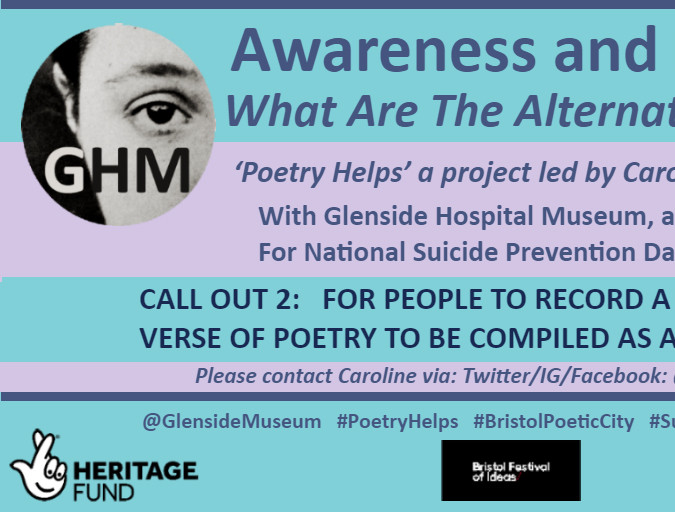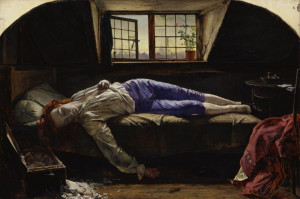#Poetry Helps: Suicide Awareness and Prevention Caroline Burrows

Share this
With Glenside Hospital Museum, I created the project Poetry Helps as part of the Poetic City programme.
Suggestions received from the public about what can help with suicide awareness and suicide prevention were compiled into a poem. Verses were posted on social media in the lead up to National Suicide Prevention Day on 10 September 2020. People were also invited to read extracts for a video recording of the poem. This is the complete text; the filmed recordings are below.
Suicide: the act; the ideation,
Even the word is often avoided,
To help prevent it, let’s start a conversation.
How should such a scary subject be worded?
Current advice recommends being direct,
So say the word ‘suicide’, be candid.
Other terms can be taken out of context.
Like ‘doing something silly’ or ‘having dark thoughts’,
Which might minimise or mock in their subtext.
One suicide survivor said she’d have been less distraught,
If she’d known of the types of help that can be sought,
That getting sectioned is only used as a last resort.
If worried about how to give someone support,
ZeroSuicideAlliance.com’s website,
Has courses online that are both helpful and short.
I watched three videos which gave me an insight,
How to approach family, colleagues, or strangers,
If I am worried and want to check they’re alright.
Other things we can learn from suicide survivors,
One told me after he shared his feelings with his partner,
That when he reached out, it brought in help from others.
Some non-verbal signs which act as indicators,
Changes in sleep, low mood, rapid weight shifts,
These might suggest suicidal behaviours.
Pay attention if someone starts taking risks,
Seems distracted, or socially withdrawn,
Things at odds with their normal characteristics.
Other things to look out for which might warn:
The giving away of prized possessions;
Anger; substance abuse; can be cause for concern.
Phrases might show suicidal ideation:
Someone might say they feel worthless, hopeless,
A burden, or alone, with no future option.
A survivor once thought putting others first was selfless,
But that meant she cared for herself less and less,
She said self-care’s not selfish; it’s needed for wellness.
Risk factors are: a sense of helplessness;
Dealing with bereavement; or unemployment;
An untreated, or an active mental-health illness;
Or chronic pain that doesn’t respond to treatment,
Such stresses might lead to someone not knowing how
To cope, or negatively affect their judgement.
These signs and symptoms show commonly how
Many factors affect someone’s mental well-being.
By talking we can help make someone ‘safe for now’.
Speak to the person, ask them how they’re feeling,
Say you’ve noticed them acting differently;
They don’t seem themselves; Can you help with anything?
If they are experiencing difficulties,
Listening shows you care, and can make a difference,
When someone feels isolated with their worries.
So you can provide the correct assistance,
Ask if someone is thinking about suicide,
To know where to go next for more guidance.
One survivor felt like part of his brain lied,
That his every negative thought got magnified,
This was his anxiety; it had catastrophised.
If someone’s having thoughts they’re trying to fight or hide,
And experiencing suicidal ideation,
There are organisations with whom they can confide.
There’s a helpline with the Samaritans,
Which can be phoned any day twenty-four seven,
Their service provides someone who listens.
Mind’s Infoline provides information,
During office hours about services,
And treatments available in your location.
For the under thirty-fives, there are advisors,
Who support those struggling, and anyone worried,
Through an organisation called Papyrus.
One man said it helped knowing there were other sufferers,
And lots of people have similar experiences,
There’s treatment for mental health, like with other illnesses.
It’s a good idea to see a GP,
To discuss medication, or what else to access,
Such as referrals to a talking therapy.
Cognitive Behaviour Therapy might help with stress,
C.B.T. finds ways to make problems more manageable,
Breaking them down so they’re easier to process.
A survivor struggled when she’d felt incapable,
Her work had set targets that were unachievable,
She’d burnt-out because she’d wrongly felt responsible.
Some GPs help make mental health more understandable,
By recommending books like ‘The Curse of the Strong’,
Which explains how no-one’s invincible.
People can break down if under stress for too long,
Books like this remove the stigma and shame,
It’s no-one’s fault when they’re ill, they’ve done nothing wrong.
There also an app: Hub of Hope is its name,
Which shows which local services are open,
The NHS lists Mental Health Apps with the same aim.
What if someone tells you they’re making plans towards action,
That they’ve been thinking about how to die by suicide,
This needs an urgent lifesaving conversation.
Make a different plan; together you can decide,
To phone a GP or 111 for an urgent appointment,
Or go to A&E to get help which they can provide.
A mental health nurse might make an assessment,
Home support could be provided in the community,
Through a referral to Crisis Team management.
One survivor was visited or phoned daily,
He said that someone checking in with him regularly,
Meant he could express his thoughts with someone openly.
Crisis Teams can make referrals to things like D.B.T.,
It’s designed to find ways to cope with intense emotions:
It’s short for: Dialectical Behaviour Therapy.
It teaches emotion regulation in skills sessions,
About considering things in different ways,
And how to help manage crisis situations.
One survivor found DBT too intense on her first day
She hated the word ‘mindfulness’, and wasn’t sure she’d stay,
But she tried all the techniques, and some worked for her okay.
If someone doesn’t feel safe at home, they can ask to stay,
With more support in one of the Crisis Houses,
Usually, these are for a set amount of days.
Some Crisis Houses run residential courses,
With a focus on therapy, skills and self-care,
The aim’s to get people back home safe with these resources.
Moderated social networks are a safe space to share:
Togetherall and Elefriends are useful additions,
People can listen and support each other there.
What do you do if someone is taking action,
With the intention to die; or if they’ve self-harmed;
This is an emergency situation.
If you’re with them, stay with them, and try to stay calm,
Ask what they’ve done; they’re doing; have they taken anything?
Take them to A&E, or call 999, about this have no qualms.
When someone’s suicidal, it can be confusing,
But if they’re accepting help, that is a good sign,
Even if it’s in an A&E hospital setting.
The hospital will treat the emergency at that time,
Crisis Teams and GPs are preferred follow-up actions,
Sectioning’s sometimes used when help and treatments are declined.
One indirect positive from hospital admissions:
Anonymised records go in a self-harm register,
Which helps keep services funded for suicide interventions.
A common message came from this suicide survivor,
She said ask for help; there is always more than one option,
That mental health’s not easy, but help makes it easier;
And talk about suicide awareness and prevention.
Watch the Recorded Readings
Further Information
Resources
- CBT/Cognitive Behaviour Therapy info: www.nhs.uk/conditions/cognitive-behavioural-therapy-cbt
- Crisis House information: https://www.mind.org.uk/information-support/guides-to-support-and-services/crisis-services/crisis-houses/
- Depressive Illness: The Curse of the Strong by Tim Cantopher: https://www.goodreads.com/book/show/4087376-depressive-illness
- DBT/Dialectical Behaviour Therapy information: https://www.mind.org.uk/information-support/drugs-and-treatments/talking-therapy-and-counselling/dialectical-behaviour-therapy-dbt/
- Elefriends, a peer-to-peer online community where people can share and support each other, developed by Mind: https://www.elefriends.org.uk/
- Golden Key in Bristol, part of Second Step, helping people with mental health needs combined with other complex matters such as homelessness, drink or drug dependence: https://www.goldenkeybristol.org.uk/complex-needs-explained/mental-health
- Mind, mental health charity whose website contains lots of resources: https://www.mind.org.uk/
- National Suicide Prevention Alliance: https://www.nspa.org.uk/
- NHS Mental Health Apps list: https://www.nhs.uk/apps-library/category/mental-health/
- Hub of Hope, listing what services are open now in your area by postcode search/location. Website and app: https://hubofhope.co.uk/
- NHS help for Urgent and Emergency mental health crises: https://www.nhs.uk/using-the-nhs/nhs-services/mental-health-services/dealing-with-a-mental-health-crisis-or-emergency/
- Papyrus, Suicide Prevention aimed at under thirty-fives: https://papyrus-uk.org/
- Richmond Fellowship Crisis House in Cumbria: North West England, an alternative to hospital psychiatric care: https://www.richmondfellowship.org.uk/cumbria
- Samaritans, a listening helpline: www.samaritans.org/
- Second Step: Housing initiative for people with mental health problems in Bristol, Bath, Somerset, & North Somerset: https://www.second-step.co.uk
- Stepping Out Theatre, a Bristol mental health based theatre company: https://www.steppingouttheatre.co.uk/
- TogetherAll, a moderated peer-to-peer online community where people can share and support each other, approved by NHS: https://togetherall.com/en-gb/
- Zero Suicide Alliance: Free video courses on how to have a lifesaving conversation: https://www.zerosuicidealliance.com/
Caroline Burrows
Caroline Burrows is a published writer of poetry, prose: fiction and non-fiction. Her poems range thematically from depression and anxiety; environmentally friendly; cycling; to love and heartbreak. She has an MA in Creative Writing, teaches writing workshops, and performs live. More work can be found @VerseCycle on YouTube/Facebook/Twitter/Instagram.
Copyright © 2020 Caroline Burrows.
A Poetic City is supported by the National Lottery Heritage Fund using money raised by National Lottery players.



